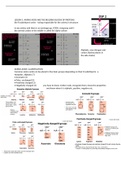DSP 2
LESSON 1: AMINO ACIDS ARE THE BUILDING BLOCKS OF PROTEINS
the R substituent varies – being responsible for the variety in structure
in any amino acid there is an aminogroup, COOH, restgroup and H
the central carbon in the middle is called the alpha-carbon
Aliphatic: one nitrogen and
carbon (hydrocarbons in
the side chains)
AMINO ACIDS: CLASSIFICATION
Common amino acids can be placed in five basic groups depending on their R substituents: •
Nonpolar, aliphatic (7)
• Aromatic (3)
• Polar, uncharged (5)
• Positively charged (3)
• Negatively charged (2) you have to know 1 letter-code, recognize them, know the properties
and know when it is alphatic, positive, negative etc.
,ADDITIONAL CLASSIFICATIONS OF 20 AMINO ACIDS
• The side chains (R) determine the differences in the
structural and chemical properties of the 20 ‘natural’ amino
acids.
• The 20 amino acid (side chain)s can be classified as
follows:
Different classifications can be applied:
• Polar (but uncharged): Cys, Asn, Gln, Ser, Thr, Tyr
• Non-polar: Ala, Leu, Ile, Val, Met, Phe, Trp, Gly and Pro
• Alcoholic: Ser, Thr, Tyr
• Sulfur-containing: Met, Cys
• Aromatic: Phe, Tyr, Trp
• Polar charged: Asp and Glu (acidic); Arg, Lys, His (basic)
• Special: Gly (no R), Pro (cyclic, imino-acid)
Several amino acids belong to more than one category.
The amino acids in the group “Polar charged” are polar even if they have no charge (charge depends
on pH).
AMINO ACIDS CAN ACT AS ACIDS AND BASES
• Amino groups and carboxyl groups can accept and donate protons
Function as weak acids and bases (e.g. compare to acetic acid)
• At low pH all groups completely protonated
• At high pH all groups donated their protons
• At neutral pH they form dipolar zwitterions no net charge
PH DEPENDENT CHARGE OF AMINO ACIDS
Blue parts: buffer regions
AMINO ACIDS CAN ACT AS BUFFERS
Around their pK values, amino acids act as
buffers as they can donate/ take up protons
CHARGE IS PH-DEPENDENT: ROLE OF PKA-
VALUES
AMINO ACIDS CARRY A NET CHARGE
OF ZERO AT A SPECIFIC PH (THE
ISOELECTRIC POINT)
• Zwitterions predominate at pH
values between the pKa values of the
amino and carboxyl groups
, • For amino acids without ionizable side chains, the Isoelectric Point (equivalence point, pI or IEP) is
• At this point, the net charge is zero – AA is least soluble in water – AA does not migrate in electric
field
HOW TO CALCULATE THE PI WHEN THE SIDE CHAIN IS IONIZABLE
• Identify species that carries a net zero charge
• Identify pKa value that defines the acid strength of this zwitterion
• Identify pKa value that defines the base strength of this zwitterion
• Take the average of these two pKa values
alternative explanation: Average the pK-values of the residues that can have the same charge (either
both positive or both negative)
PI-VALUES OF PROTEINS
• Possible to calculate? Yes
• Simple examples = peptides
Predict the pH-value at which the net charge is zero. Take the average of the pKa-values directly
below and directly above the estimated pI-value
pK1: acid COO-
pKr: rest
pK2: base NH3
For example: HAD histidine alanine aspartate
First amino acid in this sequence has a free NH3, the last one has a free COO so..
pK1 pKr pK2
H (histidine) X 6.00 9.17
A (alanine) X X X
D (aspartate) 1.88 3.65 X
charge
At pH1: +2 pI (IEP): pKr H + pKr D / 2
At pH2.5: +1 6.00 + 3. = 4.83
pH 5: 0
on the test there will be a pKr value in it!
You measure the pK value when charge = 0, so the 2 values where the protein is 0 between
PROTEIN CHARGES
• Just like amino acids proteins will be charged differently depending on pH
• Rule of thumb:
- pH above pI overall negatively charged protein (anion)
- pH below pI overall positively charged protein (cation)
• Useful in chromatography selection
FORMATION OF PEPTIDES
• Peptides are small condensation products of amino acids
A CLOSER LOOK AT PEPTIDE BONDS
Water comes free -> condensation reaction
Peptide bond (between peptide)
SECONDARY, TERTIARY AND QUARTERNARY STRUCTURE





